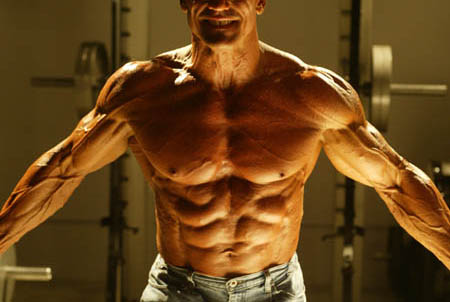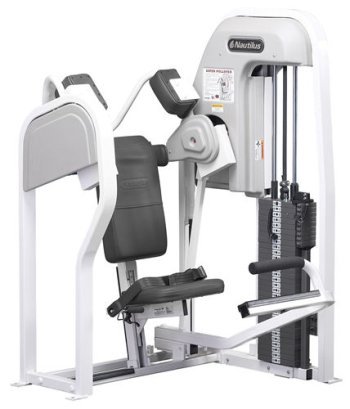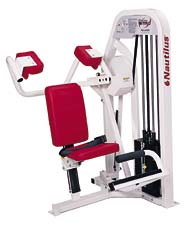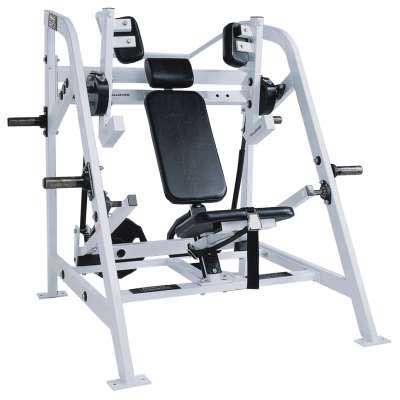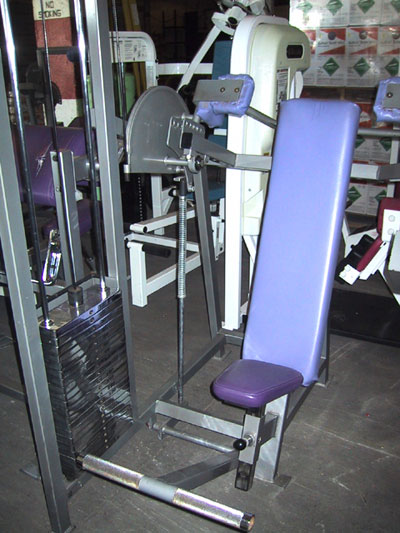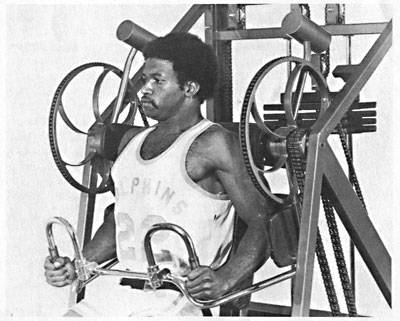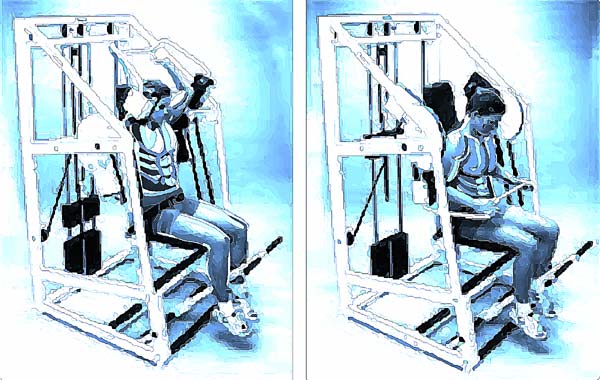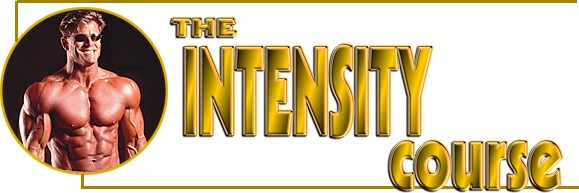
|
SUPER PULLOVER ROUTINE: The Torso Blaster! Learning to master the pullover machine can add more than just variety to your upper body workouts. The brain child of Nautilus founder Arthur Jones, this machine offers a unique and complete upper body workout. Built in the late 60's and marketed in the 70's to the public, this was the first truly innovative machine in over 100 years. Jone's created it in a quest to build the "perfect exercise" machine devoid of sticking points and the leverage flaws of traditional machines and free weights and with a full range of motion. Jones succeeded with the super pullover and brought back/torso training to a new level. What is really fun about this machine, especially for the advanced man that has been lat pulling or chinning for years, is that you can push your back to the next level, to failure and beyond, in compete saftey--and your hands don't give out first! Find a gym that has one and use it!
Start slowly with the Super pullover exercise with light weights and give yourself months (not weeks) to build up to heavy weights. And trust me, you will build up. This exercise works the entire torso. It will be worth it. Be careful with your shoulders. This exercise should always be performed with control. No jerking movements. That being said I do perform semi-fast reps while doing 1/3 bottom movements, which I will describe in a moment. Those are safe. The full movement I do SLOW. Super Pullover Training: Sit upright in the machine. Have your shoulders in line with the pivot of the machine. Generally you have to sit a little lower than you might think to get this position right. Experiment for a few minutes with the seat height adjustment till you feel you are in the correct groove while performing the pullover movement. Relax the hands and push from the back of the triceps against the pad. Let your back contract as you push against the resistance. Don't hunch forward (excessively) or or lean forward as you bring the bar down. Sit upright. As you finish the movement you can lean slightly forward contracting the abs and chest as you complete the movement. Hold the bar at your abs for a pause and then raise the bar very slowly. How far should you go back? Not too far. The machine can hurt your shoulders with it's greater than normal arc or range. Raise the bar back to about the position you would be if you were at the top of a lat pull. Don't risk going back any further. The pullover machine can work the back and lats like nothing else as it takes the hands and arms out of the equation as much as possible. The full range movement is like a chin, a row, and pullover all at the same time. Work hard on mastering the superpullover. It will build your torso in a unique and powerful way. There is truthfully nothing else like it. THE PARTIAL RANGES
The partial ranges (the top of the arc, the middle of the arc and the bottom of the arc) can be used as exercises all by themselves, with different weight schemes. Move slow during your reps. The bottom of the movement is the strongest point and you can load up the weights. I love to do these bringing the bar up about 14 inches from the bottom, then jamming it back down to my abs. It's like intense rowing. I like to rep out with it occasionally. It's very intense on the abs and rear delts. The top of the pullover movement is upper back blast and feels much like a dumbbell pullover. All those muscles that tie into your armpit and lat are blasted by doing partial reps at the top of the pullover. Weights are light as you're in a position of weak leverage at the top of the arc. The Slo-Mo training camp has discussed the benefits of the pullover machine. The machine lends itself to doing slow motion reps if you desire. Actually performing the first reps super slow on any exercsie is a good idea, but especially on the pullover. As you tire, start to push harder with more momentum, you may not even be movng faster (as you are tired) but the "feeling" is one of faster exertion. Again this is a great way to perfrom any set: start slow and end "fast" or at normal rep tempo(even though you are not actually moving fast). I think the pullover deserves as much attention as the squat and bench press. If you dedicate yourself to this exercise it will pay back bigtime. Your shoulder joints need time to strengthen once you begin a program of pullovers, so take it easy. It's easy to hurt the rotator cuff with sloppy form or improper warm-ups or just plain over use. One more word of caution. Under your trapezius in your upper back are a set of small stabilizing muscles that are used to counter balance your arms (as they push from the elbow) as you perform the superpullover. You can easily pull these muscles, even as an advanced person. Be sure to warm up carefully. Be on guard for this as you learn the movement. A good variation is actually grabbing the bar with an underhand grip and doing bottom arc rows. Let the bar come up 14 inches and then pull back down to the abs. This is a really nice feel and using the hands lets you pile on some weight. For the most part I try my best to NOT use my hands while doing pullovers. I really push hard against the pads and isolate my back, my hands are lying on the bar but not pulling.
|
SHRUGGING
ROUTINES SPECIAL ADVICE
Shrugging in all it's forms can be a very powerful aid to developing
strength. Start slow and be careful. Master each shrug as you decide to
learn them. The results are nothing short of incredible. A couple months
of shrug work can add considerable weight to your lift maximums. I didn't
believe it at first. You might not either. Shrugging trains your muscles
in a unique and intense fashion. You must try it for yourself.
I was first introduced to shrugs through the writings of Paul Kelso. At first I dismissed it. What a bunch of nonsense I thought. However, years later when I was having trouble getting stronger on a continual basis I started doing Kelso shrugs on a chest supported rowing machine for my back. I figured what the hell I had nothing to lose. I wish I had done them years earlier. The entire shrug system or method of training is very productive. The Kelso shrugs worked. Kelso shrugs are shrugs done on an incline bench or row device with arms extended holding the weight. Using just the movement of your shoulder girdle and scapula you draw the weights backwards, squeezing your shoulder blades together. You can really build up to some tremendous poundage's in shrugging and I did. Soon I was rowing more than ever. Kelso was right all along.
Many kinds of shrugs:
Soon I experimented with all sorts of shrugs. You can apply the shrug principle to just about any piece of equipment you use in the gym that requires your hands and some that don't. Exercises like the Shrug Squat. I started doing them to improve my squat. It worked! I did shrugs on the dip bars. I did shrugs on my lat pulls and chins. And yes I even did regular shrugs. The routines made me sore in places I don't often feel sore. it was fantastic. After a time, these movements made me feel very strong in the center of my body. The middle back, the entire shoulder girdle, rhomboids, chest and lats, all of them felt connected like never before.
Shrug machines:
Hammer Strength makes a nice one as do several companies. Nautilus made one years ago you did not use your hands with to perform the shrug. I have seen several "hands free" machines but have not experienced them first hand in a training environment. I have used the Hammer Strength unit and I like it. It works seated and standing with different grips available. One of the things I like most about this machine is that you can do deadlifts with it as well. I face into the machine and deadlift and the arc of movement is very smooth.
Half movements and partial reps:
Shrugs led to me doing a program of unique half movements and static holds that I had good leverage in. These half lifts or even shorter allowed me to lift considerable weights. I did lat pulls for about an 8 inch range of movement (under hand grip), from about chin level to chest. I did 1/5 rep dips with as much weight as I could humanly attach to the dip belt. I did bench and squats and deadlifts with short heavy lifts, that were very close to nothing more than static holds with heavy weights. Lifting heavy dumbbells as if I was going to one arm row them, just picking them up holding them for a few seconds and putting them down, really helped. You can pick up a lot more weight than you can row. Try it, it works.
Shrugs and partial rep movements can be done together in the same workouts or training cycles as they do have similar strength benefits and movement similarities. You can rotate their use as well. After several months of shrugging, several months of half rep work would be a good follow up, then returning to full range of motion reps for a complete cycle. Be careful to rest several days between workouts. Be prepared to be sore. Your joints and connective tissue take a real beating with this sort of training.
My advice is experiment with various shrug movements just as I did and see what works for you. Shrugs can be done as a separate routine or as sets at the end of regular sets. Work on them for several months and you will be impressed by the results. I have included a list of my favorite shrugs and some half movements that I suggest you try.

LAT PULL SHRUGS: Variations include: wide grip, medium grip, under hand grip, over hand grip, on chinning bars, and between cross over cable machines. Grab the bar and shrug (with the lats and back), contracting and drawing downwards and back with the scapula muscles. See illustration below FIGURE 6.
FIGURE 6: Lat Pull Shrugs. Draw downwards with the back muscles drawing the scapula together.
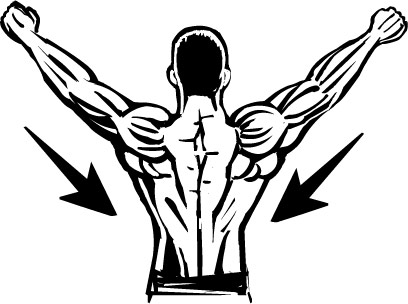
DUNN LAT PULLS: A movement introduced to me by bodybuilder John Dunn, I have found very effective combined with lat pull shrugs on a cable cross over machine. I call it the Dunn Lat Pull. Stand between a cable crossover, stretch fully and pull downwards bringing the upper arms to the ribs. Focus on just letting the back muscles do the work. SEE FIGURE 7.
FIGURE 7. DUNN
LAT PULLS
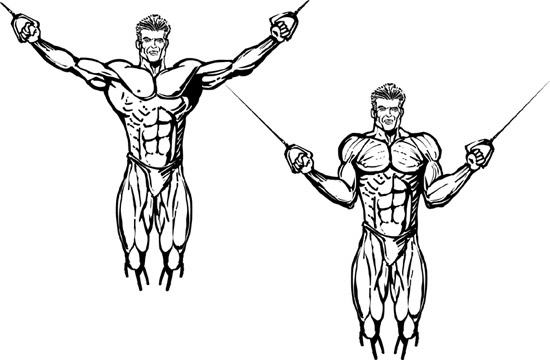
DIP SHRUGS:
In the dip position let the shoulders drop down then using
the force of the arms and delts and torso bring your body
upward at the same time arching and rounding the back bringing
the buttocks high. You end up in a crescent shape. You can do them
with a straight back with head up. Experiment with different form. Wonderful
for serratus development.
BENCH SHRUGS: Using a bar or dumbbells lock out on the bench. Using the torso shoulder girdle (and not the arms) move the weight forward (or upwards) contracting the chest and shoulders, then downward and repeat. If you are using dumbbells you can bring the bells together at the top and contract your chest. Experiment with wide and close grip form. SEE FIGURE 7
FIGURE 7: BENCH
SHRUGS: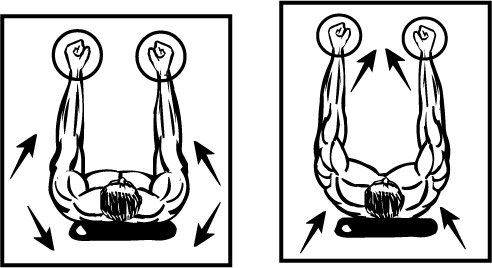
KELSO SHRUGS: Face down on an incline bench holding a bar or some dumbbells and draw backwards using the muscles of your back and scapula. Various grips and widths should be explored. One of my favorites.
